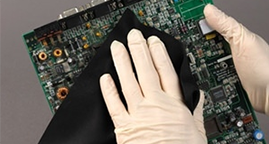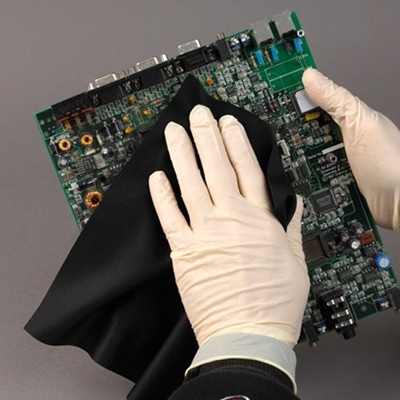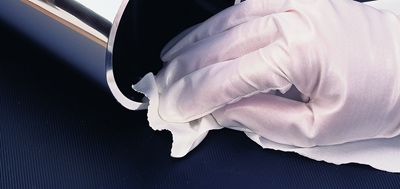The whole point of wiping a surface with a cleanroom wipe is to remove contaminants including dust, dirt, oil, greases, soot, getting the flux off and so on. But, after wiping, how clean is the surface? How can it be guaranteed? How can an operator or quality inspector be sure? Visually inspecting the wipe is the quickest and easiest way to check cleanliness. If the wipe looks dirty and the substrate looks clean, the wiping process was successful. That works well if the wipe and the contaminants are contrasting colors. Since most wipes are white (a sign of cleanliness perhaps) black or darkly color soils are easily seen. However, many contaminants are not dark colored. Instead they are white or light colored. Since they are the same color as the wipe, visually inspecting the used wipe is not completely useful. This is especially true if the contaminant is particulate; especially small particulates.
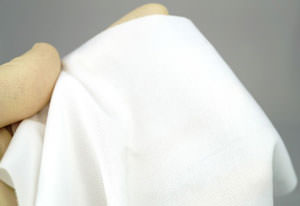
White polyester wipe hides contamination because of lack of contrast.
Visually inspecting the wipe is the quickest and easiest way to check cleanliness. If the wipe looks dirty and the substrate looks clean, the wiping process was successful. That works well if the wipe and the contaminants are contrasting colors. Since most wipes are white (a sign of cleanliness perhaps) black or darkly color soils are easily seen. However, many contaminants are not dark colored. Instead they are white or light colored. Since they are the same color as the wipe, visually inspecting the used wipe is not completely useful. This is especially true if the contaminant is particulate; especially small particulates.
Color is actually specific energies of light waves which fall into the range of wavelengths humans are able to see, the visible spectrum between red and violet. Objects appear to have color since they selectively absorb and reflect certain wavelengths of visible. For example when a blue object is hit with white light rays the object reflects only wavelengths that we see as blue light and absorbs all other light, that is, all the other wavelengths of light.
As particles become smaller and more dispersed, their actual color or lack of color (transparency) becomes less visible and the light scattering effect becomes more visible. For example, Mie Scattering is responsible for the white appearance of clouds. Cloud droplets are transparent water but with a diameter of 20 micrometers or so, they are large enough to scatter all visible wavelengths more or less equally. This means that almost all of the light which enters clouds will be scattered. Because all wavelengths are scattered, clouds appear to be white. Liquid particle counters rely on Tyndall Scattering to report determine particle numbers and measure turbidity in a sample.
Consequently, dust and particulate contamination is not reliably detected by white wipes. Instead, ‘cleanroom clean’ black wipes have been developed to clearly and visibly show small particulate contamination. Black inspection wipes like Coventry™ Poly Double-Onyx™ were originally developed to be the final check of the cleanliness of hands and faces (make-up and cigarette smoke particles) of workers entering class 10 cleanrooms in semi-conductor and other micro-electronic manufacturing. However, their properties make them useful for both the final wipe down and for the final inspection of any surface in a critical environment or anywhere particles compromise quality or performance.
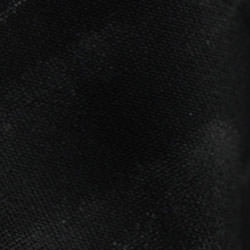
Close-up of contamination on the black wipe material.
Inspection wipes must have the following properties since they either clean the surface to its ultimate cleanliness or make final contact with the surface after the final cleaning.
- Cleanliness - The inspection wipe must be at least as clean as the most critical wipe used in the cleaning process. In
fact it should be the cleanest wipe. Therefore it must be cleanroom laundered to remove all particulate, non-volatile (NVR) and ionic contamination. Preferably, it should have sealed edges or sealed borders since this is where much contamination is shed from wipes. - Absorbency - The absorbency of the inspection wipe must equal or surpass all the other wipes used in the cleaning process so it can be the final cleaning and catch any contamination left by the previous wiping.
- Durability - The wipes must be colorfast and resistant to any chemical or mechanical (abrasive) attack. Pure 100% monofilament polyester is ideal for this task and the reason why it is used in the cleanest cleanroom wipe.
- Visibility - The particles and contaminants must be clearly visible on the wiper. Dark contaminants are clearly visible on the typical white wipe. However, the most
jet black wipe is necessary to see all other remnant contaminants. Blue wipes are not adequate. - Properly sized - the wipe must be large enough (6”x6” minimum; 9”x9” preferred) to be properly manipulated
Coventry™ Poly-Onyx™ cleanroom polyester wipes meet
The best way to use an inspection wipe is to quarter fold it. The wipe is then held in the hand with the laser or heat cut edges in the palm. The thumb should hold the four cut corners in the palm of the hand while the fingers apply gentle wiping pressure on the wipe, just behind the folded edges. The wipe can then be refolded to expose four fresh cleaning surfaces that are neither touched by the hands (or gloved hands) of the wiped surface. This is the same method recommended for
Is it clean? Black inspection wipes, like Coventry™ Poly-Onyx™ 6259BESD answer that question – and make it so.
Technical and Application Assistance
Chemtronics provides a technical hotline to answer your technical and application related questions.
The

